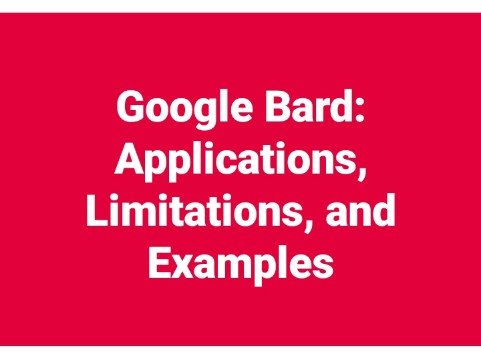
Google AI Applications, Limitations, and Examples
Google Bard: Applications, Limitations, and Examples
Google Bard is a large language model (LLM) chatbot developed by Google AI. It is powered by the LaMDA (Language Model for Dialogue Applications) technology, which allows Bard to communicate and generate human-like text in response to a wide range of prompts and questions.
Applications
Google Bard has a wide range of potential applications, including:
- Content generation: Bard can be used to generate high-quality, SEO-optimized content for websites and blogs. It can also be used to create marketing materials, social media posts, and other types of content.
- Creative writing: Bard can be used to help writers generate ideas, brainstorm plots, and write characters. It can also be used to help writers improve their grammar and style.
- Education: Bard can be used to create interactive learning experiences for students. It can also be used to help students with their homework and assignments.
- Customer service: Bard can be used to provide customer support to users. It can answer questions, troubleshoot problems, and provide technical support.
Limitations
Google Bard is still under development, so it has some limitations. For example, it can sometimes generate text that is not factually accurate or that is not relevant to the prompt. It can also be biased in its responses, depending on the training data that it is given.
Examples
Here are some examples of how Google Bard can be used:
- A content marketer could use Bard to generate blog posts about new products or services.
- A writer could use Bard to help them brainstorm ideas for a new novel.
- A teacher could use Bard to create interactive learning activities for their students.
- A customer service representative could use Bard to answer questions from customers about their products or services.
Google Bard for Creative Writing
Google Bard can be a valuable tool for creative writers. It can help writers generate ideas, brainstorm plots, and write characters. It can also be used to help writers improve their grammar and style.
Here are some tips for using Google Bard for creative writing:
- Start by giving Bard a clear prompt. For example, you could ask Bard to generate a character who is a detective, a spy, or a superhero.
- Be specific in your prompts. The more specific you are, the more likely Bard is to generate text that is relevant to your needs.
- Use Bard to brainstorm ideas. Don’t be afraid to experiment with different prompts and see what results you get.
- Use Bard to help you improve your grammar and style. Bard can help you identify errors in your writing and suggest ways to improve your style.
Google Bard for Content Generation
Google Bard can also be used to generate content for websites and blogs. It can create high-quality, SEO-optimized content that is both engaging and informative.
Here are some tips for using Google Bard for content generation:
- Start by researching your topic. The more you know about your topic, the better Bard will be able to generate content that is relevant and accurate.
- Use clear and concise language. Bard is still under development, so it may not be able to understand complex or technical language.
- Use keywords throughout your content. This will help your content rank well in search engines.
- Proofread your content carefully before publishing it. Bard may make mistakes, so it is important to catch any errors before they are published.
Conclusion
Google Bard is a powerful tool that can be used for a variety of purposes. It can be used for creative writing, content generation, and customer service. As Bard continues to develop, it is likely to become even more powerful and versatile.









Leave a Reply